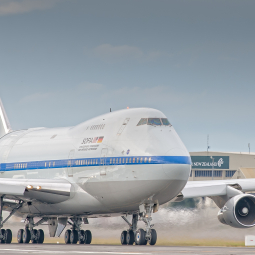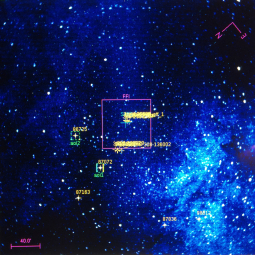NASA’s Stratospheric Observatory for Infrared Astronomy, SOFIA, is preparing to head to Christchurch, New Zealand, to study celestial objects best viewed from the Southern Hemisphere. Observations will include targets that are too low to observe or not visible at all from the Northern Hemisphere — including our neighboring galaxy the Large Magellanic Cloud , the center of our own Milky Way galaxy , and Saturn’s moon Titan .
As in previous years, SOFIA will operate from National Science Foundation’s U.S. Antarctic Program facility at Christchurch International Airport. But this is the first year that the observatory’s newest instrument , the High-resolution Airborne Wideband Camera-Plus (HAWC+), which can study celestial magnetic fields, will be used in the Southern Hemisphere.
“In the Southern Hemisphere, the center of our Milky Way galaxy is almost directly overhead, putting it in a prime location for us to observe it,” said Jim De Buizer, Universities Space Research Association’s SOFIA senior scientist. “We can also see the the Magellanic Clouds, which have an environment similar to the early universe, letting us study star formation there as a proxy for what it was like in the early universe.”
Over seven weeks, 25 overnight flights are planned. Some highlights of the planned observations include:
- Studying the evolution of Eta Carinae , the most luminous and massive stellar system within 10,000 light-years of Earth. It’s shrouded in dust and gas from its previous eruptions and is expected to explode as a supernova in the future. Researchers will analyze the dust and gas to learn more about how this violent system evolves.
- Creating images of the celestial magnetic fields found in the center of our Milky Way galaxy. Scientists know that this area has strong magnetic fields that affect the material spiraling into the black hole, flowing away from past supernova explosions and forming new stars. But they want to better understand the shape and strength of these magnetic fields, to gain new insights into how they impact the processes in the our galactic center.
- Mapping the Tarantula Nebula , also called 30 Doradus, which has a cluster of thousands of stars forming at once. Once the stars are born, their light and winds push out the remaining material from their parent clouds — potentially leaving nothing behind to form more new stars. Researchers will map the speed and direction of the molecules in the nebula to determine if the material is expanding, forming new stars or if the star formation process has been stunted.
- Analyzing the atmosphere of Saturn’s largest moon Titan . Researchers will chase down the shadow cast by Titan when it passes in front of a distant star in an eclipse-like event called an occultation. SOFIA’s mobility enables the telescope to be positioned exactly in the shadow’s center. From there, researchers can study Titan’s atmosphere to learn how it may change with its seasons. Now that the Cassini spacecraft has ended its mission , these events are the only way to continue monitoring Titan.
- Studying the material ejected from and swept up by Supernova 1987A , which may become the building blocks of future stars and planets. Many telescopes have studied it, including the Hubble Space Telescope and the Chandra X-ray Observatory , but the instruments on SOFIA are the only tools available to study the debris around it at infrared wavelengths, which will reveal characteristics that cannot be measured with other wavelengths of light.
SOFIA is a Boeing 747SP jetliner modified to carry a 106-inch diameter telescope. It is a joint project of NASA and the German Aerospace Center, DLR. NASA’s Ames Research Center in California’s Silicon Valley manages the SOFIA program, science and mission operations in cooperation with the Universities Space Research Association headquartered in Columbia, Maryland, and the German SOFIA Institute (DSI) at the University of Stuttgart. The aircraft is based at NASA’s Armstrong Flight Research Center Hangar 703, in Palmdale, California.
Updated on June 6, 2018 to reflect that SOFIA will fly 25 flights from Christchurch, New Zealand.
Points of Contact
Nicholas A. Veronico
650.224.8726 cell
Nicholas.A.Veronico@nasa.gov

